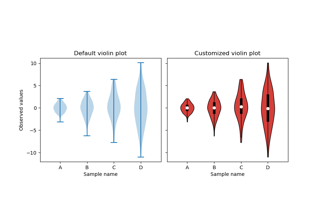matplotlib.axes.Axes.violinplot¶
-
Axes.violinplot(dataset, positions=None, vert=True, widths=0.5, showmeans=False, showextrema=True, showmedians=False, quantiles=None, points=100, bw_method=None, *, data=None)[source]¶ Make a violin plot.
Make a violin plot for each column of dataset or each vector in sequence dataset. Each filled area extends to represent the entire data range, with optional lines at the mean, the median, the minimum, the maximum, and user-specified quantiles.
Parameters: - datasetArray or a sequence of vectors.
The input data.
- positionsarray-like, default: [1, 2, ..., n]
Sets the positions of the violins. The ticks and limits are automatically set to match the positions.
- vertbool, default: True.
If true, creates a vertical violin plot. Otherwise, creates a horizontal violin plot.
- widthsarray-like, default: 0.5
Either a scalar or a vector that sets the maximal width of each violin. The default is 0.5, which uses about half of the available horizontal space.
- showmeansbool, default: False
If
True, will toggle rendering of the means.- showextremabool, default: True
If
True, will toggle rendering of the extrema.- showmediansbool, default: False
If
True, will toggle rendering of the medians.- quantilesarray-like, default: None
If not None, set a list of floats in interval [0, 1] for each violin, which stands for the quantiles that will be rendered for that violin.
- pointsint, default: 100
Defines the number of points to evaluate each of the gaussian kernel density estimations at.
- bw_methodstr, scalar or callable, optional
The method used to calculate the estimator bandwidth. This can be 'scott', 'silverman', a scalar constant or a callable. If a scalar, this will be used directly as
kde.factor. If a callable, it should take aGaussianKDEinstance as its only parameter and return a scalar. If None (default), 'scott' is used.
Returns: - dict
A dictionary mapping each component of the violinplot to a list of the corresponding collection instances created. The dictionary has the following keys:
bodies: A list of thePolyCollectioninstances containing the filled area of each violin.cmeans: ALineCollectioninstance that marks the mean values of each of the violin's distribution.cmins: ALineCollectioninstance that marks the bottom of each violin's distribution.cmaxes: ALineCollectioninstance that marks the top of each violin's distribution.cbars: ALineCollectioninstance that marks the centers of each violin's distribution.cmedians: ALineCollectioninstance that marks the median values of each of the violin's distribution.cquantiles: ALineCollectioninstance created to identify the quantile values of each of the violin's distribution.
Notes
Note
In addition to the above described arguments, this function can take a data keyword argument. If such a data argument is given, the following arguments can also be string
s, which is interpreted asdata[s](unless this raises an exception): dataset.Objects passed as data must support item access (
data[s]) and membership test (s in data).
